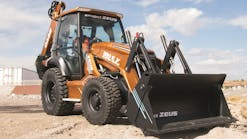If you’re like most grading and excavating contractors, moving dirt is the easy part of your job. Keeping that dirt from leaving your site in the form of mud stuck to the tires of trucks and or as dust blowing in the wind can be a whole lot harder.
Containing dirt, mud, and dust on a construction site isn’t just a good idea. It’s also the law. The US Environmental Protection Agency’s National Pollutant Discharge Elimination System (NPDES) rules require the project owner or contractor to protect air and water quality to minimize offsite transport of sediment, whether by stormwater runoff, wind, or other means.
In addition to the environmental threats, muddy streets and clouds of dust can pose a safety hazard to motorists. What’s more, very fine dust particles can impair health by causing respiratory problems.
“Dust or mud that escapes from your work site is one of the first things that can cause compliance problems for a contractor, because they leave a highly visible trail that a regulator can follow right back to your project,” says Alex Zimmerman, certified professional in erosion and sediment control (CPESC), who is a consultant with CSI Geosynthetics in Vancouver, WA. “The costs of fines and cleanup, not to mention potential liability problems, for noncompliance can be very expensive.”
Tips for Better Control
Here are some suggestions to help you limit the amount of mud tracked onto streets and roads by trucks exiting your job site.
Manage traffic-“A trackout control practice, such as a rock pad, rumble strip, or wheel wash at your construction site exit points, won’t magically solve the problem,” Zimmerman says. “Muddy streets are usually the result of driving trucks through too much dirt and mud before they get to the trackout-control device. It’s amazing how many times I’ve seen a large mud puddle right before a trackout-control BMP.
“Analyze how you manage traffic on your site-not just the trucks coming in and going out, but where they are traveling on your site. Plan your haul roads and other traffic areas to minimize travel distances. Otherwise, you’ll have a much more difficult time keeping up on the amount of mud and dirt that builds up on the tires. Installing temporary pavement in some areas may also be worthwhile.”
One advantage of in-ground systems is that the tanks for holding the wash water can be installed underneath the unit, minimizing the unit’s footprint.
Build and maintain rock pads properly-A rock trackout pad is designed to shake dirt and mud from truck chassis, wheels, and tires as a truck rolls across the rough surface. It requires high maintenance to continue functioning properly, says sediment and erosion control consultant Jerry Fifield, CISEC (Certified Inspector of Sediment and Erosion Control), CPESC, president of HydroDynamics Inc., Parker, CO. This type of control must be installed properly, including the use of a geotextile underneath it to help prevent rocks from sinking into the ground.
Sizing the rock is important, too. He prefers rock no larger than about 3 to 5 inches in diameter. “They’re large enough that they won’t get carried off in-between the treads of the tires, but in really muddy conditions they can still become embedded in mud that sticks to the truck,” Fifield says. “Rocks bigger than this size can lodge in between the duals and could be thrown back onto following vehicles when driving down the road.”
Be sure to keep the surface rough, adds Zimmerman. Over time, repeated traffic will tend to push the rocks down, creating a smooth surface, which won’t shake the truck as needed. He suggests using equipment-such as a dozer and ripper, or the teeth of an excavator bucket-to keep the rock surface loose and uneven. Also keep sediment from building up on the surface. “If you can’t see voids between the rocks, it’s time to replace with clean material,” he says.
Correct use of rumble strips-Rumble strips use a series of steel bars to shake the truck as it is driven over them. They are much more effective than a tracking pad, Fifield notes. But, they must be long enough to do the job.
“I’ve seen some as short as 10 feet,” he says. “A longer unit, maybe 25 to 50 feet in length, depending on site conditions, will provide time to dislodge mud and dirt on the truck.”Zimmerman recommends anchoring rumble strips into the ground or placing them on solid ground to prevent them from moving around when a truck rolls over it. Otherwise, the device could deflect under the weight of the truck and come up to damage the truck’s underside.
The spaces in between the bars of a rumble strip or rattle rack also need to be kept open to collect dirt and mud that falls from the truck. If they are plugged, the tires will simply pick up the sediment and track it off site.
Zimmerman suggests using this type of control in conjunction with a rock pad. “Leaving the soil in front of the rumble strip bare will only cause more dirt to be dislodged and fall into the first few feet of the steel bars, requiring more maintenance to keep this section of the rumble strip clean,” he says. “Installing a rock strip immediately before the truck rolls over a rumble strip will reduce sediment buildup in this area.”
Keep wash water clean and contained-Although a relatively new concept in North American, wheel-wash systems have been used since the early 1980s in Europe, where environmental regulations required a more effective alternative to rock pads and rumble strips for containing sediment onsite. Since introducing its line of wheel washers to the United States six years ago, Moby Dick has watched demand increase steadily. “We’ve seen a dramatic increase in the acceptance of wheel wash systems among American contractors,” says Robert Lodi, sales manager for MobyDick Wheel Washing System. “Their use has expanded from permanently installed systems at landfills and quarries to portable units used at construction sites. The demand is being driven by environmental protection regulations and by the desire of contractors to be a good neighbor.”
Wheel-wash systems also require proper maintenance to ensure the wheels, tires, and truck underbody all are washed with clean water. Using a flocculent can help increase the amount of sediment that drops out of suspension. “In addition to pumping sediment out of the wheel-wash tank, you can add a polymer flocculent and run that water through a second tank, where more sediment will drop out before that water is recirculated through the system,” Zimmerman explains.
If you’re dealing with a lot of dirt and mud, another option is to add a box to increase tank capacity of a portable wheel wash. Some contractors make their own by welding a plate to one end of culvert, he reports.
In most cases, because the wastewater in a wheel-wash system typically contains such pollutants as heavy metals, oils and grease, which aren’t allowed to enter a storm drain, you may need to use an oil boom or skimmer device, a cartridge filter, or an absorbent media to remove hydrocarbons before disposing of the wastewater in a sanitary sewer or through evaporation, Zimmerman adds.
Sweep up your mess-If mud does get tracked onto adjacent streets and roads, Zimmerman recommends using a sweeper, not a rotary broom, to clean it up.
“A rotary broom pushes mud and dirt into the curb line where it eventually washes into the storm drain system,” he says. “And, if the mud is dry, you’ll create dust. A sweeper, on the other hand, picks up the material so that it can’t cause further problems.”
Selecting an Effective Wheel-Wash System
When it comes to preventing trackout, it’s tough to beat an automatic wheel-wash system in terms of speed and effectiveness.
Consider an example provided by Roxanne Garrett, president of Neptune Automated Wheel Wash Systems in Hot Springs, AR.
One of her customers, working on commercial building project in Georgia, was spending about an hour and 20 minutes at the start of every day washing mud and dirt off the wheels of its dump trucks by hand. “After they installed our system, they had every truck rolling in about 15 or 20 minutes,” she says.
In a typical wheel wash, a truck is driven across a series of steel bars mounted on a platform. As it rolls along, a series of nozzles sprays the tires and the underside of the truck with water from a recirculating water system.
Among the features she suggests considering when selecting a wheel-wash system.
Type of soil can determine the best length of the washing platform.
A portable tire-wash system can be delivered and installed in 24 hours.
Design-Consider, for example, how difficult the system is it to move and to install. How complicated is it to operate? A self-supporting system can be placed in or above the ground, to fit various site conditions.
“Because aboveground units require no excavation to install, setup time is shorter than an in-ground unit,” Lodi says. “Generally, they work very well for removing sand and medium loam sediment. The in-ground units tend to do a better job removing larger quantities of sticky clay, like mud that gets stuck between the duals.”
Another advantage of in-ground systems in that the tanks for holding the wash water can be installed underneath the unit to minimize the unit’s footprint, he adds.
Models that feature a modular design that are assembled on site can save time and effort when installing them.
Lodi notes two other useful features to consider: an integrated scraper-conveyor system to remove sediment from the water recycling tanks for proper disposal and the ability to control the rate of water spraying onto the tires to adjust for varying degrees of difficulty in washing off the sediment. “That way, if the material is easy to remove, you can reduce the water volume and pump pressure,” he says. “Or, for sticky material, you can increase the flow and pressure as needed.”
Ivyland, PA-based Stanton Systems is an innovator in wheel-wash technology.
During the site development of a new subdivision in Central City, PA, Howell’s Construction was contacted by the county inspector, who had noticed mud and debris coming from the construction site being tracked by all the vehicles entering and exiting the location.
“We ran into some problems last night with the heavy rains,” says Donald Durango, foreman with Howell’s Construction. “We had a problem on Green Street, at the new development. There was mud from the previous night’s rain going everywhere. What we had promised to do and what was going on that day were two different things.”
Durango talked to Dennis Stanton at Stanton Systems and asked him if he could help with the problem. Right after the conversation, Stanton had his team load up a portable tire-wash system. It was delivered and installed within 24 hours.
“They did a good job,” says Durango. “No wonder Stanton Systems has been so successful manufacturing tire-wash systems for more than 22 years.”
When the county inspector returned he was pleased to see the streets and sidewalks clean of tire tracks and mud.
Size-An 11-R-24 tire has to roll 11.5 feet to achieve one full tire rotation, she notes. That means the platform should be at least 12 feet long to wash the entire tread of one tire. Also the wash platform for each wheel needs to be at least 42 inches to be able to fully wash a set of dual tires.
Type of soil-This determines the best length of the washing platform. A system may be able to wash off sand and granular soils in just one tire revolution. Sticky clays, on the other hand, may require a washing platform long enough for the tires to make three revolutions.
Number of trucks-The more trucks washed per hour, the larger the recycled water capacity needed to allow solids to settle. By increasing the rate of solid settlement, the use of flocculents can reduce the size of the water recycling system.Water pressure-A system that uses high water pressure requires nozzles with small diameter orifices. These can clog up faster than the larger orifices used with low to moderate pressure systems, which rely on more water volume rather than high pressure to clean off dirt and mud. In fact, a high volume-low pressure system, that has left and right wash elements to direct the spray to the tires with no water spraying from a middle wash element, will prevent washing oil, grease and other contaminants off of the truck’s undercarriage, Garret notes.
Roller technology– In cases where soil is extremely sticky, or for “zero-tolerance trackout,” even a drive-through platform that allows tires to make three revolutions may not provide adequate cleaning. In that case, a system which uses rollers to capture and automatically spin the wheels multiple tire revolutions to completely clean the tread profiles can be a better choice, Lodi notes.
Dealing With Dust
Although dust from construction sites is commonly associated with arid and semiarid climates, under the right conditions it can be a problem on earthmoving projects anywhere in the country. For example, Fifield has seen large housing developments in Florida where building pads constructed of very fine coral sands were left unstabilized. “I couldn’t believe all the dust created when the winds came up,” he says.
Fifield describes a typical dust-generating scenario at a construction site. To maximize profits, a contractor denudes as much of the site at one time as possible, he notes. But, this leaves the sites more vulnerable to wind erosion.
Vegetation helps slow the wind, reducing its erosive force, and anchors the soil in place. Removing the vegetation eliminates this protection. Also, it accelerates drying of the soil, making it more susceptible to erosion. At the same time, grading activities smooth out terrain features that help reduce the impacts of wind on the soil. “As a result, once the wind starts blowing, you can have a heck of a dust-control problem,” Fifield says.
One way in which wind moves sediment is by carrying fine soil particles suspended in the air, he notes. Accounting for about 10% of all windblown particles, suspension can create large dust clouds and storms that blow across continents and even oceans.
About 50% to 70% of windblown sediment bounces along near the soil surface in a process called saltation. Once dislodged by the wind, a majority of these soil particles, which are suspended sediment, rise no more than about 6 to 12 inches above the surface. As they drop back to the ground, they disturb even more particles, repeating the process until the wind stops.
“This problem is worse on soil surfaces that are baby-bottom smooth,” Fifield says. “You can disrupt this by roughening up the ground with ridges or leaving mounds along the side of utility trenches. It’s the same principle that farmers use when they leave 3- to 6-inch-high crop stubble in their fields to reduce wind erosion.”The largest of the windblown particles, those too heavy to be carried in the air, roll or creep along the ground. It’s the same process that produces sand dunes.
Minimizing Air Pollution
The best material for controlling dust, says Fifield, is vegetation. “Keep vegetation on a construction sites as long as practical,” he advises. “Then, after your excavating and grading work is done, revegetate the site and cover it with mulch as soon as possible. Don’t delay and don’t skimp on the amount of vegetation and mulch.”
In fact, the EPA requires that a construction site must be stabilized within 14 days of final grading. In humid areas, that’s usually long enough for seeds to begin germinating, However, in arid regions, lack of adequate moisture can delay germination and establishment of vegetation for some time.
That’s when other approaches for controlling dust are needed. However, Zimmerman doesn’t recommend the conventional use of water as one of them. “In dry areas, some earth moving contractors follow heavy equipment around a job site with a truck spraying water in an attempt to knock dust out of the sky,” he says. “It just doesn’t work, because it’s not practical. If you pre-wet the site and allow the soil to dry it will form a crust. That crust will control wind erosion, but only if you don’t drive on it. Once you do, you break the crust, rendering it useless for controlling dust.”
As with minimizing track out of dirt and mud, planning ahead can make dust control easier.
“Most contractors I’ve seen have been way too reactive about controlling dust,” Zimmerman says. “They wait until they start seeing dust before taking any action. By then, it’s too late. You must be proactive and stay ahead of the dust. Any dust control practices must be used before dust starts. If you fall behind, you’ve lost the battle, because you can’t remove dust from the air.”
Advance planning also includes good traffic management practices. “Traffic is the big enemy of dust control,” he says. “Start your dust control practices before dust begins. Then, stay off of the treated areas or minimize traffic on them and repeat treatment as needed.”
Another option is to keep the soil surface rough. It’s much more effective in reducing wind erosion than a smooth surface. “Sometimes, simply disking or roughening up the soil with a tiller or other implement can prevent dust formation,” he says.
Installing a rock sub-base immediately after establishing the sub-grade can also eliminate dust as well as track out problems. “This practice is becoming more popular, but you need to put the rock down right away,” Zimmerman says. “Even if you have to dig through it later to install utilities, this approach can pay off. It’s also easier to work off of a stabilized, rock surface than a bare, muddy site, if it rains.”
The choice of an organic polymer or synthetic organic dust-control product is generally determined by the individual project.
Dust-Control Choices
Using water to control dust on active areas, like haul roads, requires frequent reapplication, sometimes as often as every 15 or 30 minutes, depending on such factors as soil type, humidity, and air temperature.
A variety of manufactured spray-on products are available that offer more cost-effective alternatives to water for controlling dust. For example, resin-modified emulsions made from tree rosin and pitch control dust on bare earth and unpaved roads penetrates by binding soil particles and road aggregate into a strong surface. Polymer-modified asphalt emulsions reduce the human health risk and environmental exposure to polynuclear aromatic hydrocarbons (PAHs) in asphalt when used for controlling dust on roads. Special surfactants can improve the ability of water to wet and suppress road dust, while calcium chloride products can suppress dust on construction sites and dirt roads by absorbing moisture from the air and locking it into the soil to create a hard-packed ground surface.
In fact, when used to create a stabilized unpaved roadway, these products can convert fugitive dust into a useful asset. Bob Vitale, president of Midwest Industrial Supply Inc. in Canton, OH, which manufacturers a variety of dust-control and other soil-stabilization products, explains.
“When real fine soil particles blow away, they’re called dust,” he says. “But, when they remain in the ground, they pack into the voids between large soil particles and aggregate to bind everything together and create a strong, durable road surface.
One of the more popular classes of dust-control agents is polymers. Made from long chains of molecules, using either organic or synthetic organic chemistry, these products can be formulated to fit various types of applications.For example, one of the Midwest Industrial Supply’s organic polymer products is Soil Sement. Made of acrylic polyvinyl acetate polymers, it can be used to control dust and soil erosion alike. It was one of the first such products to feature nanotechnology chemistry, Vitale reports. The product is a mix of water and supramolecular polymer chains, each about 100 million molecules long. Each individual molecule measures less than 100 nanometers in size.
“When you spray the product on the ground, the million-molecule polymer chains soak into the soil, where they surround the fine soil particle and lock onto each other with great strength to hold the sediment in place,” Vitale says. “These polymers are very resilient and durable. When the water evaporates, you have a cured bonded surface of soil particles. Depending on the specific chemistry, you can make the molecular binding system as strong as steel or as pliable and flexible as string.”
The product can be used to control dust on open graded areas until vegetation can be established, as well as other uses, such as stabilizing building pads or dirt roadways.
Unlike organic polymers, which cure to produce a hard soil surface, synthetic organic dust-control agents feature entirely different chemistry, which enables them to remain continuously active after they have been applied. They include Midwest Industrial Supply’s EnviroKleen and EK35 products. “These biodegradable products combine US EPA environmentally defined attributes with very unique organic binders that cause fine soil particles to adhere to each other,” Vitale says. “Even thought the treated soil particles remain loose, the product prevents them from being released into the air as they are disturbed.
The choice of an organic polymer or synthetic organic dust-control product depends on the individual project. For example, if you want to produce a hard, tightly bound surface for a dirt road, then an organic polymer is a better choice, Vitale says. But, if your goal is to control dust on an open space while retaining a natural look to the soil surface, or if you need to prevent formation of dust on roads where trucks are spilling dirt, then the continuously active synthetic organic chemistry would be better.
Advice for Buyers
Vitale offers the following advice when selecting any type of dust control agent.
Verify product safety information-Check the product label and other documents describing any environmental and human health and safety issues associated with the product and require aquatic toxicity testing, which may affect the product’s suitability for your project. Also look for an industry or government certificate verifying the accuracy of any such information and manufacturers’ marketing claims.
Consult with your vendor and/dust control contractor-To ensure selection of the most appropriate products for your project, inform your vendor and contractor about your specific dust-control objectives, your budget, and any special considerations, such as the presence of nearby bodies of water or any required permits.
Require a guarantee-“You should expect your vendor to stand behind the performance of the product and explain how any product failures will be handled,” Vitale says.
It’s not possible to completely eliminate every telltale sign of mud or dust leaving your job site. But, by adopting the appropriate practices, using them properly and working closely with your erosion control vendors and contractors, you can keep moving dirt in a way that protects both your profits and the quality of our air and water.







